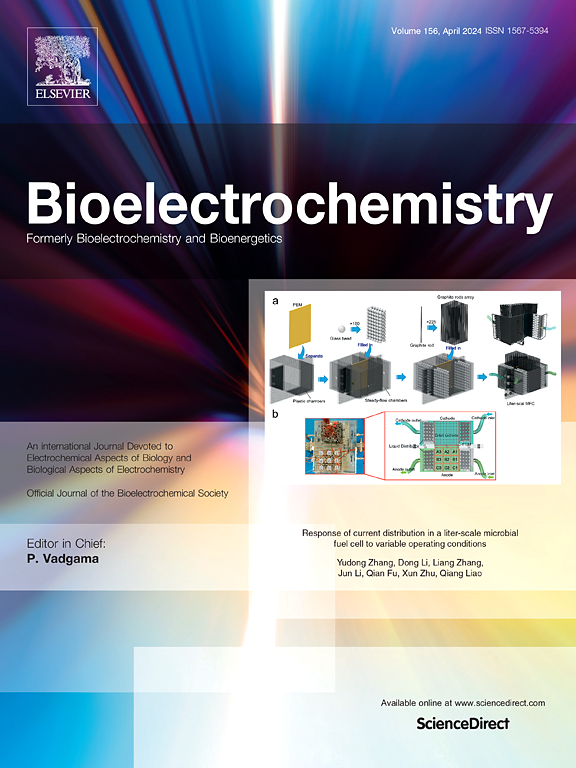A novel hybrid biosensor for miRNA detection based on peptide nucleic acids and molecularly imprinted polymers
IF 4.8
2区 化学
Q1 BIOCHEMISTRY & MOLECULAR BIOLOGY
引用次数: 0
Abstract
The detection of miRNAs serving as key biomarkers in cancer diagnostics is challenging due to their small size, low abundance, and high sequence similarity, which complicates their sensitive and selective detection. Here, we report a biosensor that combines molecularly imprinted polymers (MIPs) with peptide nucleic acids (PNAs) to achieve a sensitive and highly selective miRNA detection in RNA isolates of cancer cells. MIPs were synthesized by electropolymerization utilizing PNA-supported and pre-oriented miR-21 templates molecules, which serve as both a linker for improved template orientation and an assistive recognition element for miRNA binding. Electrochemical impedance spectroscopy (EIS) was used to detect miR-21 after optimization of the sensor architecture and the experimental parameters. The sensor exhibited excellent sensitivity and selectivity toward miR-21 even when compared to the single mismatched sequence, with a linear response of 0.5–5000 pM and a limit of detection (LoD) of 0.11 ± 0.04 pM without any amplification steps. The sensor was used to quantify miR-21 in artificial serum and in RNA isolates of cancer cells to discriminate between MCF-7 and Hela cells. This approach opens new avenues for the application of MIPs as synthetic antibodies in miRNA research and emphasizes the importance of the synergistic integration of PNA.
基于肽核酸和分子印迹聚合物的新型杂化miRNA检测生物传感器
作为癌症诊断关键生物标志物的mirna的检测具有挑战性,因为它们体积小,丰度低,序列相似性高,这使得它们的敏感性和选择性检测变得复杂。在这里,我们报道了一种结合分子印迹聚合物(MIPs)和肽核酸(PNAs)的生物传感器,以实现对癌细胞RNA分离物的敏感和高选择性的miRNA检测。MIPs是利用pna支持和预定向的miR-21模板分子通过电聚合合成的,它既是改善模板定向的连接体,也是miRNA结合的辅助识别元件。优化传感器结构和实验参数后,采用电化学阻抗谱(EIS)检测miR-21。即使与单个错配序列相比,该传感器对miR-21也表现出出色的灵敏度和选择性,线性响应为0.5 - 5000pm,检测限(LoD)为0.11±0.04 pM,无需任何扩增步骤。该传感器用于定量人工血清和癌细胞RNA分离物中的miR-21,以区分MCF-7和Hela细胞。该方法为MIPs作为合成抗体在miRNA研究中的应用开辟了新的途径,并强调了PNA协同整合的重要性。
本文章由计算机程序翻译,如有差异,请以英文原文为准。
求助全文
约1分钟内获得全文
求助全文
来源期刊

Bioelectrochemistry
生物-电化学
CiteScore
9.10
自引率
6.00%
发文量
238
审稿时长
38 days
期刊介绍:
An International Journal Devoted to Electrochemical Aspects of Biology and Biological Aspects of Electrochemistry
Bioelectrochemistry is an international journal devoted to electrochemical principles in biology and biological aspects of electrochemistry. It publishes experimental and theoretical papers dealing with the electrochemical aspects of:
• Electrified interfaces (electric double layers, adsorption, electron transfer, protein electrochemistry, basic principles of biosensors, biosensor interfaces and bio-nanosensor design and construction.
• Electric and magnetic field effects (field-dependent processes, field interactions with molecules, intramolecular field effects, sensory systems for electric and magnetic fields, molecular and cellular mechanisms)
• Bioenergetics and signal transduction (energy conversion, photosynthetic and visual membranes)
• Biomembranes and model membranes (thermodynamics and mechanics, membrane transport, electroporation, fusion and insertion)
• Electrochemical applications in medicine and biotechnology (drug delivery and gene transfer to cells and tissues, iontophoresis, skin electroporation, injury and repair).
• Organization and use of arrays in-vitro and in-vivo, including as part of feedback control.
• Electrochemical interrogation of biofilms as generated by microorganisms and tissue reaction associated with medical implants.
 求助内容:
求助内容: 应助结果提醒方式:
应助结果提醒方式:


